
History is often taught as a story in which a succession of monarchs went in search of heirs and of land. The heirs ensured posterity – think of the lengths to which Henry VIII went to secure his succession – while land ensured space and food for their population, which in turn encouraged prosperity and stability. Even after monarchs were replaced by dictators or democracies, the lust for land continued. Kwasi Kwarteng suggests another way of looking at history (recent history, at least), and has written a book that places gold – the need for it, the search for it and the value of having it – at the centre of global history.
The subtitle is slightly misleading. The book does consider some 500 years of empires, adventures and debt, but the first four centuries are dealt with in 70 fact-packed pages. These start with Philip, heir to the great Charles V, declaring bankruptcy in 1557, less than two years after he became Holy Roman Emperor.
There is plenty of empire, adventure and gold in this first section of the book, not least in the Americas, where the Spanish adventurer Hernando Cortés told the Aztecs that he was suffering from a disease of the heart that could only be cured by gold. Inca Peru provided even more gold to settle that "disease", much of which went to finance war in Europe and, inadvertently, to usher in the modern world. It was the 20th-century economist John Maynard Keynes's assertion that our modern age was created by the accumulation of capital, and that capital came from the influx of gold and silver from the New World.
Kwarteng, a Cambridge-educated historian and currently a Conservative MP, is as fond as Keynes of making pronouncements, among them this one: "The need to pay for wars was the principal engine of modern finance." But the need to mount campaigns was not the only engine, nor the only part of this book that will resonate with readers. The account of the 1720 "bubble", where shares in the South Sea Company soared and crashed, leaving some rich and others (including a director of the Bank of England) bankrupt, makes depressingly familiar reading.
War and Gold takes off when the narrative reaches 1914, a time when most major economies were still tied to a "gold standard", their currencies in some way pegged to the amount of gold held in national reserves, of which Fort Knox became the most famous. The unparalleled calamity of the 1914-18 war burdened the UK with such massive debt that it was forced to leave the gold standard, yet gold remained the anchor of sound economies.
For people brought up in the internet age, the concept of an economy propped up by a rock, a hill, a mountain of gold might seem quirky. If so, Kwarteng's detailed tracking of the shift from gold to paper will come as a revelation. The century to 1914 had been one of balanced budgets in Britain, a century during which the national debt actually fell. The century since 1914 is another matter: in the seven years following the outbreak of the first world war, Britain's national debt rose by more than 1,000%.
Kwarteng makes sense of the main moments of global and (specifically, but not exclusively) western monetary history, from the consequences of the first world war to the boom and bust of the 1920s; from the financial consequences of the second world war to the extraordinary achievements of the Bretton Woods conference. Held in July 1944, Bretton Woods established a new world financial order, created the IMF and the precursor of the World Bank, but kept gold as the stabilising factor. The agreement survived until the early 1970s, when President Nixon, attempting to deal with the consequences of the Vietnam war, ended the link between the dollar and gold.
One of this book's central premises is that our governments' need to accumulate treasure has been "a powerful impetus behind developments in society". Yet, as is shown here, the rise of oil, the coming of China and the creation of the euro (a direct result of Nixon's ending of the Bretton Woods agreement) all led not to great social development but to the financial crisis of 2008. That crisis was, in some ways, a social development, but one whose consequences we will be facing for many years to come.
Kwarteng's ambitious attempt to make sense of the modern history of money is unlikely to make readers feel secure about the future. The collapse of European economies under the weight of huge government debt, the continuing arguments as to whether we should spend our way out of recession or cut government borrowing, and, on a global scale, China's reluctance to fix its currency to gold because it would slow down its export business will all continue to darken the immediate global economic outlook.
If there is light in this dark cloud, it comes from the author himself. Politicians have often been criticised for lacking a long view of history. This exhaustive and convincingly argued history of money comes from an author whose day job is to sit in the House of Commons. Kwarteng might not know how to stabilise a financial system that floats on credit, but he certainly understands the forces and the mistakes that have led to that destabilisation.

